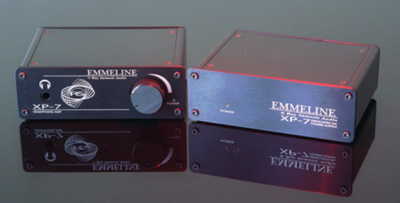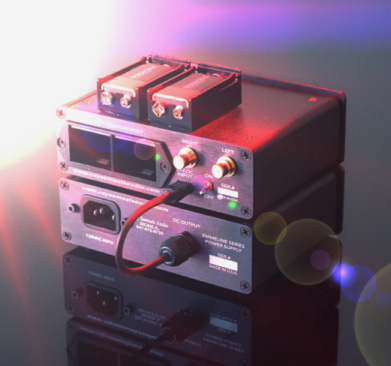You are reading the older HTML site
Positive Feedback ISSUE
11january/february 2004
ray samuels audio
Emmeline XP-7 headphone amplifier
as reviewed by Gary Beard

LOUDSPEAKERS ELECTRONICS SOURCES CABLES ACCESSORIES
|
I thoroughly enjoyed my time with Ray Samuels’ Emmeline HR-2 headphone amp, so it was with great anticipation that I awaited the arrival of his latest creation, the Emmeline XP-7 portable headphone amp. Why a portable? Well, because of portability! (Doh!) Good portable sources abound today—CD, MP3, laptop computers, Minidisc players—and I assume most owners listen to them with headphones most of the time, if not exclusively. Why then should audiophiles (as well as quasi-normal music lovers) have to suffer with the sound of the mediocre to downright awful headphone amps that are designed into many of them? The answer (less obvious, perhaps) is that we don’t. Headphone aficionados have been toting around portable amps for some time. There are a number of companies, both big and small, that make portable amps, but it is nice to see that Ray Samuels has added another on-the-go amp to the short list of truly high-fidelity offerings.
The XP-7 in Use
The Emmeline XP-7 ($495 for the amp sans power supply) may be a little too big for extreme applications, since at approximately 5 x 4 x inches it is not exactly pocket-sized. While some may balk at taking the XP-7 on a walk around the block, a small bag with an MD player or (oxymoron warning!) a good-sounding MP3 player, the XP-7, and a good pair of headphones would make a smashingly musical time of a long road trip. If this was the XP-7’s only use, it would be an unlikely candidate for most portable amp buyers, but due to some interesting design features, this is not the case. The first consideration is the amp’s extremely long battery life. Mr. Samuels has found a neat sliding battery compartment that allows two 9-volt alkaline batteries to be installed side by side. This gives the XP-7 power for a period approaching forty hours, which is really amazing considering the fact that the amp outputs enough juice to drive the 300-ohm load of my Sennheiser HD600 headphones without breaking a sweat. Most folk’s aren’t likely to drag the big Senns onto a plane, but they might take them to the office, throw them into a suitcase for a vacation at the beach, or listen to them while sunning their buns in the backyard (while sipping a cold one, of course). There is one more compelling reason to buy an XP-7—it can either be purchased as a stand-alone battery unit or, for $225 more ($695 if purchased together), you can add the optional 120-volt power supply and have an excellent headphone amp for your home system as well.
Design
Once again, Ray Samuels has designed a unit that is sleek and simple, with rock-solid build quality and a small footprint. The XP-7 is a solid state amplifier that uses the Analog Devices AD825 as its stock op amp. Operational amplifiers have their own sound characteristics (sort of like vacuum tubes), and since the op amps Samuels uses in the XP-7 are socketed, you can change them if you prefer a different sound flavor. The amplifier section sits directly on top of the power supply and connects with a small umbilical cord. There is a switch on the back of the amp that allows the choice of battery or 120-volt power. If battery power is selected, the amp is on, so you must flip the switch back to the 120V setting to turn the batteries off. The amp also has a front-mounted headphone jack, high quality Alps volume potentiometer, and red power LED. The high quality gold plated RCA jacks are rear mounted, along with the battery compartment and the female 120-volt power umbilical connector. The optional power supply has a red power LED mounted on the front and the umbilical cord and an IEC power connector on the back. In the 120-volt mode, the amp remains on as long as it is plugged into a power source. The Ray Samuels trademark build quality is in strong evidence—the design of the XP-7 is well executed in every respect.
The Sound of Emmeline
If memory serves, the sound of the Emmeline XP-7 is similar to that of its non-portable brother, the HR-2. Even though they use different op amps (the stock HR-2 uses an AD797), the "house" sound is still apparent. If you read my review of the HR-2, it should come as no surprise that I like the sound of the XP-7. When using the optional power supply, the sound is full, well extended, transparent, and without any undo coloration as far as I could tell. The bass is very good—reasonably deep, very tight, and solid as a rock. There are a few things that the XP-7 does not do quite as well as its stablemate. While already naturally limited by headphones, the soundstage of the XP-7 is a bit flatter, the images slightly smaller and less airy, and the stage is more tightly located between the ears. The XP-7 also seems to be more sensitive to the quality of the source material. Music is never rendered unlistenable, but don’t expect the XP-7 to make a silk purse out of a sow’s ear. It simply plays back what you feed it. I suspect the op amp in use may be the cause, but I was not able to confirm this suspicion.
As the XP-7 is a portable amp with a creative solution to battery power, I was keen to get a sense of how this attractive option performed. I popped out the sliding battery compartments and installed two new 9-volt alkaline batteries. Mr. Samuels cautioned me not to mix brands or new and old batteries, so I made sure they were a fresh pair. I connected the amp to my computer’s 6Fire DMX soundcard’s RCA line outputs with a pair of MIT Terminator 3 interconnects, plugged in my Sennheiser HD600 headphones, and threw Harry Connick Jr.’s She CD into the CD-Rom drive. I was immediately greeted by a toe-tappingly balanced, highly resolved sound. Sounds emerged from a quiet, black background with excellent rhythmic drive. The sound was very extended and dynamic, yet smooth. I know a lot of audiophiles hate the use of the term "musical," but if I define the term as "extremely enjoyable reproduction of music," this combo fits to a tee.
Those of you familiar with She know how much deep bass is present. Drums and bass guitar have great impact and extension, and the battery-powered XP-7 handled it all without complaint. Treble was very good too—cymbals shimmered, bells sparkled, and electric guitars raved on. The midrange of the XP-7 is very good, and well balanced with the bass and treble. Vocals are smooth and believable, without a hint of sibilance. Next, I spun the Sheffield Lab compilation CD, Cr�me de la Cr�me. I have used this CD with every headphone amp review I’ve done, as it gives great insight into the ability of the amp to reproduce varied material. The first cut, "Amanda," would not, at first listen, seem to be difficult to reproduce, but its peaceful nature, interspersed with big dynamic swings and Amanda McBroom’s powerful vocals, can really show off a system. The XP-7 on batteries sounded good, but was missing some of the air, texture, and dynamic contrast of the Emmeline HR-2. However, the XP-7 did a great job with Tower Of Power’s high-energy "What is Hip," providing a detailed, brassy, and kick-booty sound. That result seemed almost counterintuitive, and I am at a loss to explain it. While a difference in recording techniques could be the explanation, my gut tells me that the op amp may once again be the culprit. Teamed with the smoothness of the 6Fire DMX soundcard/MIT combo, the XP-7 seemed to have found a particular synergy. This bodes well for a potential owner, as it would seem to be the perfect use for this amp. Think about it—all you have to do is throw the XP-7 in your briefcase along with a good pair of cans, connect it to a good portable source, and your boss won’t be able to wipe the smile off your face.
As with all audio equipment of which I am aware, the Ray Samuels Audio Emmeline XP-7 portable headphone amplifier is not perfect. Due to its resolving power, the XP-7 needs a good source and good source material to really strut its stuff. I tried it briefly with my Creative Nomad Zen Nx MP3 player, and while the sound was much better than with my Sennheiser PX200s driven directly, the trial made it painfully obvious that even relatively high-bit-rate 320k MP3 files are noticeably inferior in sound quality to an uncompressed .wav file. When the XP-7 was connected to my reference digital source, the Cary 303/200 CD player, the "little amp that could" really came alive. I immediately noticed a larger soundstage, and the resolution of inner detail became more apparent. On Shaun Colvin’s very fine Steady On CD, I could pick out the individual voices of the male and female backup singers with ease, which was somewhat of a surprise since I had never noticed this to that degree before. The bass was much deeper than with my computer-based sources, but I also felt that the lower midrange/upper bass was slightly recessed. The sound was never tinny or bright, but there was an emphasis in the upper mids that left the music sounding just slightly out of balance. The Cary’s ability to retrieve minute details, along with its additional treble extension, gave the Samuels amp more bite, but also allowed me to hear the recording’s imperfections a little too well at times. I have noticed before that the 80s pop style of recording used on Steady On can give it a bit of unwanted digititis in spots, so the XP-7 was being truthful to the music.

Generally speaking, the XP-7 gracefully handled all the music I played, and all the sources I used, without wavering, yet once in a great while it sounded a little congested on extremely demanding musical passages. Again, its soundstage and images are somewhat flatter and smaller than that of the best amps I’ve heard, and I am not sure if I like the sound of the AD825 op amp. My personal preference would probably include changing to the AD797, as I have slowly become convinced that its sound is more to my taste, and would perhaps make the XP-7 resemble its big brother, the HR-2, even more closely.
Am I being ultra-critical about the sound quality of the XP-7? Perhaps, but when I wear my reviewer hat, I need to be that way for credibility. However, at the end of the day, when I hang that sweat-stained fedora in the closet (okay, maybe that is a bit much), the audio/music lover in me thinks this little dynamo of an amp is the berries. The XP-7 is transparent, detailed, generally uncolored, dynamic, and exciting to listen to. Its tonality is very good. It has nicely extended treble, tight, deep bass, and a midrange that doesn’t overpower the rest of the frequency spectrum. The sound is remarkably similar whether using 120-volt power or batteries. While the XP-7 is not small, because of its solid build, long lasting battery power, and fine sound, it is both a winner as a portable and equally adept in the home system. I highly recommend the XP-7. If you are in the market for a high end headphone amp with a small footprint, reasonable price, excellent sound, and the tremendous versatility of a portable—and with Ray Samuels generous return policy as an incentive—this amp is a must-audition. Gary L. Beard
XP-7 portable headphone amplifier
Retail: $495
Ray Samuels Audio
web address: www.raysamuelsaudio.com
